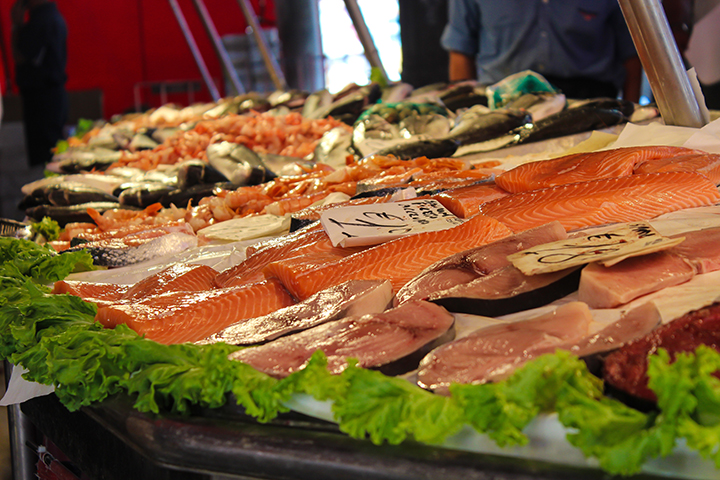As we sit down to enjoy our meals, we often forget to consider the journey our food took to reach our plates.
Fish is considered a highly nutritious food due to the abundance of its essential nutrients, such as Omega-3 fatty acids, vitamins, and minerals. Omega-3 fatty acids help keep our heart and brain healthy, while also aiding infant development in pregnancies. Since our bodies cannot naturally produce Omega-3, we must get it through the foods we consume. To maintain a healthy diet, the American Heart Association recommends eating fish at least twice a week. With the increasing demand for fish, fish farming has become a popular and cost-effective way to provide fish to our tables. Navigating the nutritional value and potential health risks of the fish you choose can be challenging, ad there isn’t a one-size-fits-all answer.
It’s commonly believed that wild-caught fish is always a healthier and safer choice than farm-raised fish. However, the truth is more complex, and both types have their own advantages and disadvantages. Wild-caught fish feed on a natural diet of plankton, small fish, and other organisms, but they face risks such as water pollution, waste, overfishing, and climate change. On the other hand, fish farms offer a controlled environment for fish to thrive in, but they can contribute to the pollution and create a genetic contamination in wild fish due to the waste they produce. Ultimately, your choice between wild-caught and farmed-raised fish should depend on your personal preferences and priorities, and being informed about the risks and benefits of eat option to help you make the best decisions.
What do farmed fish eat?
Farmed fish are typically fed pellets that resemble dry dog food. The feed contains a variety of nutrients that are essential for the fish’s growth and development, with the exact ingredients varying depending on the species. To ensure that fish receive all the necessary nutrients, nutritionists have designed the feed to contain up to 40 different essential nutrients. The most commonly used ingredients in fish feed, as reported by the National Oceanic and Atmospheric Administration (NOAA), include fishmeal, fish oil, soy and corn (plant proteins), and animal trimmings.
Antibiotic use is a common practice in fish farming to prevent disease, but when done improperly, it can negatively impact the safety and quality of the fish we consume. Overuse of antibiotics can lead to bacteria developing resistance, rendering the antibiotics less effective in treating infections. This can result in the spread of antibiotic-resistant bacteria in both humans and fish, which poses a significant health concern. These bacteria can spread to humans through contaminated food, water, or other environmental sources, leading to prolonged health issues, increased healthcare costs, and, in severe cases, even death.
Furthermore, the use of antibiotics in fish farming can have negative effects on the environment. The antibiotics can leach into surrounding waterways, potentially harming aquatic organisms and disrupting ecosystems. It’s essential to be mindful of antibiotic use in fish farming and to support sustainable practices that prioritize the health and well-being of both fish and the environment. After all, the health of both is closely linked to our own well-being and the choices we make can have a lasting impact on our planet and ourselves.
Tips on Making a More Informed Seafood Choice
Choose wild-caught fish: You can find wild-caught fish in many supermarkets, local fish markets, and online stores. When choosing wild-caught fish, make sure to look for labeling and certifications that guarantee the fish was sustainably sourced and harvested using responsible environmental practices. Key phrases to watch for include “wild-caught,” “line-caught,” or “sustainably sourced.” Be mindful that wild-caught fish can be more expensive than farmed fish, as cost of catching and processing wild fish is typically higher.
Check for sustainability: Make sure to choose fish that have been sustainable caught or farmed. This means that the fish have been raised or caught in a way that minimizes environmental impact and prioritizes fish welfare. Checking for sustainability can help you make an informed choice when purchasing fish. You can check for certification labels on the fish or do research on the company that is selling the fish. Third-party organizations, like Marine Stewardship Council (MSC) or the Aquaculture Stewardship Council (ASC) offer certifications that indicate responsible fishing or farming. Be sure to look for these certifications to ensure that you are making a responsible choice for your health and the environment.
To learn more about these certifications and what the labels look like, check out Global Services for more information.
Making an informed choice about the fish we consume is crucial for our health and the well-being of the environment. While both wild-caught and farmed fish have their advantages and disadvantages, it’s important to prioritize sustainability and responsible fishing or farming practices when making purchases. By checking for sustainability and doing proper research on the companies we buy from, we can ensure that we are making a responsible choice for our health and the environment.
Provided, will be a helpful tool to make decisions easier about your seafood purchase, check out Seafood Watch, where you can select the type of fish you’re interested in and receive recommendations on whether to avoid farmed-raised or wild-caught options.
By Cierra West
MIS researcher and writer
Know someone who might be interested in this article? Share it.




